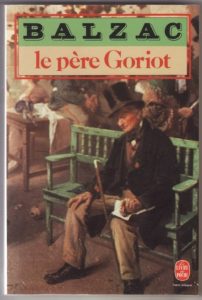Balzac, Le Père Goriot (La Pension Vauquer)
un extrait de Le Père Goriot Honoré de Balzac (France, 1799-1850)
un extrait de
Le Père Goriot
Honoré de Balzac
(France, 1799-1850)
 Many consider Honoré de Balzac the father of French, if not European, realism. He is best known for his complex, morally ambiguous characters who, when described in great detail, become very human, very real to his readers. The same holds true for the settings of his stories. Set in France in the post revolutionary era – otherwise known as the Restoration (1814-1830), beginning with the abdication of Napoleon I and the return to the throne of the Bourbon king, when nobles were reclaiming their fotrtunes while the poor suffered the consequences, and while the stark division between between the classes was again taking shape – Balzac’s descriptions displayed a keen eye for observation and placed a critical mirror in front of the society trying to live through these transitions.
Many consider Honoré de Balzac the father of French, if not European, realism. He is best known for his complex, morally ambiguous characters who, when described in great detail, become very human, very real to his readers. The same holds true for the settings of his stories. Set in France in the post revolutionary era – otherwise known as the Restoration (1814-1830), beginning with the abdication of Napoleon I and the return to the throne of the Bourbon king, when nobles were reclaiming their fotrtunes while the poor suffered the consequences, and while the stark division between between the classes was again taking shape – Balzac’s descriptions displayed a keen eye for observation and placed a critical mirror in front of the society trying to live through these transitions.
His life’s work, the La Comédie Humaine, is a multi-volume collection of novels and short stories, all interwoven, sharing characters and settings, and telling the tales of the Restoration from various viewpoints. In Le Père Goriot, we hear the story of a few characters, and we are especially touched by that of its title character, Le Père Goriot, who is gradually ruined financially in order to support his two selfish, manipulative and dishonest daughters.
In order to save money, Le Père Goriot rents a room in a “pension”, a boarding house. A snapshot of that rundown house in Paris is a great reflection of French society as a whole at that time. Balzac doesn’t disappoint and opens his novel with a very detailed description of the “Pension de Madame Vauquer.”
Stratégies de lecture:
- 1ère lecture: Read the entire text while listening to the accompanying recording. Don’t worry about meaning, just listen and try to read along.
- 2ème lecture: Reread the text while hovering over words that you may not understand (not all words are translated for you) and while completing the accompanying exercises.
C’est bon? D’accord, c’est parti!
Cliquez sur la flèche pour continuer.
